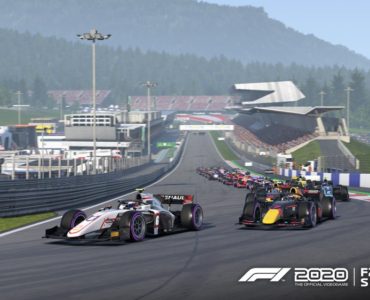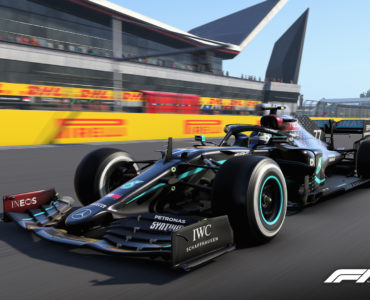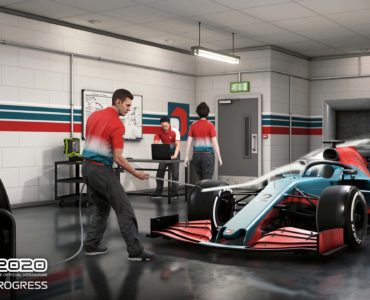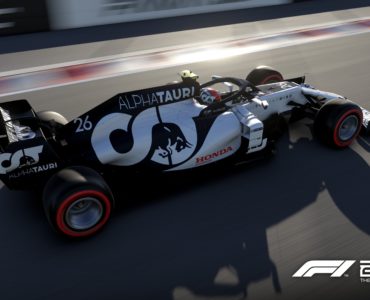Back in 2008 Codemasters announced to have acquired the Formula One license, promising to bring annual Formula One games to the PC & gaming consoles.
Now, F1 2010 is here, being the first official Formula One game for the PC since EA Sports’ F1 Challenge 99-02 that dates back to 2003. The pre-release hype surrounding the title has been met with doubts in the sim community as Codemasters past titles such as Race Driver GRID and Dirt have done little to impress the fans of realistic racing.
So, is F1 2010 realistic enough to please sim racers or is there another issue that overshadows the driving experience? Read the review to find out!
It’s somewhat hard to believe that is has been seven years since an official Formula One game has been released for the PC but the past years have seen the license being confined to Sony consoles.
Starting with the now-legendary Grand Prix by Geoff Crammond, Formula One has been a popular topic on PCs for many years. The genre was at its high at the start of the century when racers had up to three different Formula One titles to choose from as Geoff Crammond’s Grand Prix series, EA Sports and Ubi Soft competed to offer the ultimate F1 title.
All three franchises have long folded though as Sony secured the exclusive F1 license in 2003, limiting Formula One games to the Playstation consoles for almost seven years. Now it’s Codemasters turn, the company has quite an extensive motorsport background, having released countless popular rallying and touring car titles.
The Title – Content
As the name suggests, F1 2010 includes all cars & drivers of the 2010 Formula One season, giving buyers access to the current Formula One cars and tracks with five races of the real season still to go.
This is especially remarkable when it comes to the Korean Grand Prix as the South Korean Grand Prix venue wasn’t even finished by the time its virtual version was created.
Codemasters could not have picked a better time to start their franchise as a bunch of new teams at the back of the F1 grid have added new flavor to the series and adding a challenge to the title’s career mode.
Aside from up tp date graphics and an extensive weather system, the career mode is one of the title’s main selling points, allowing players to work their way up from teams like Virgin to the F1 powerhouses of Ferrari or Red Bull.
Installation & Getting Started
Regardless of whether you buy the boxed version of F1 2010 or buy the title on Steam, getting it ready to run will take quite a while.
Following installation, the title requires players to sign up with Games for Windows – LIVE, a service used by many modern games. While many avid gamers may already have a LIVE account, many sim racers will be signing-up first as no racing simulation has used the system before.
Once you??re signed in to LIVE, the title gets the player directly to the beginning of the career mode after the first start as the career length and first team has to be chosen in a press-conference-like system.
Following that, a non-skippable tutorial on the menu system needs to be completed before you can head out to the track for the very first time. Between installation, LIVE sign-up and the tutorials, 30 minutes can easily pass until you can start racing – A unusual issue for users of racing simulations who are used to get to the point straight away.
Graphics
With past Codemasters titles such as GRiD having received lots of praise for their spectacular graphics, many people had high expectations of F1 2010’s and the developers do not disappoint as the title is easily one of the best looking racing games ever created.
While discussions about lighting and graphical effects such as HDR and bloom come down to personal taste, the overall graphical quality of F1 2010 is stunning as Codemasters have cut very few corners in terms of optical presentation.
Aside from a generic steering wheel used for all cars due to time restraints with the driver animations, all cars have been accurately modeled after their real-life counter parts, sporting good looking textures and proper lighting.
Even though initial plans to laser-scan the Formula One venues had to be dropped during development, the tracks are superbly modeled and come with an almost endless amount of details – especially the street circuits.
While racing in Monaco has often felt like driving in a tiny bit of scenery in other simulations, F1 2010’s rich details manage to re-create the thrill and excitement that drivers must feel racing a 700hp race car through a narrow street.
With the title already looks mighty impressive in dry conditions, the wet weather races look even more stunning with great water effects, good looking puddles and reflections.
From rain drops on cars and camera lenses to the heat from engines flaring in the distance, it’s safe to say that the graphical presentation is very close to being flawless.
Sounds
The sounds in F1 2010 are not much to complain about either as the engine sounds are solid work and as high-pitched and shrieking you??d expect a Formula One car to sound.
Codemasters haven’t gone the lengths to create unique sounds for each car which is not much of a miss as F1 engines sound largely the same and only one title has paid this much attention to the sounds in the past.
The usual ambient sounds like tire sounds, curbs, crashes and track ambiance are spot on and the menu music is unintrusive enough to not annoy you.
The most unique sound aspect about F1 2010 is definitely the race engineer that is always with you on the radio. While other titles have had features like that before, the extend to which your team communicates with you is a novelty.
Info from the race engineer ranges from basic stuff like warnings about the tire and engine temperatures and positions to helpful feedback regarding the weather situation, remaining session time and more.
The only downside is that some of the audio samples tend to get repetitive very quickly and could have used some more variety, some of the info provided is useless now and then as well – Why would I care to know if the leaders pit while racing for 20th in a Virgin?
Physics & Force Feedback
The F1 2010 physics discussion has been raging in the community ever since the first video was released so let me cut to the chase right away: No, F1 2010 is not iRacing and does not qualify as a hardcore simulation in any shape or form.
But, unlike past titles like Race Driver GRID which had ridiculous physic gaffes, Codemasters have done respectable job with trying to please both casual gamers and fans of realistic driving.
With all aids off, F1 2010 feels like a slightly toned-down version of other simulations with the cars handling in a believable manner. Compared to the recently-released Ferrari Virtual Academy, you can feel that there are definitely still driving assists at work as the cars handle more forgiving, especially in terms of braking.
While slowing down the car in FVA is a delicate task, tires in F1 2010 won’t lock that easy as it requires quite hard braking while yanking on the wheel to get the rubber to lock up.
Same goes for traction control as the cars definitely don’t spin out as easy as they would without any traction control. Hitting the curbs wrong or putting down too much throttle in the rain will spin you out though so there’s definitely a large degree of realism involved.
Since the majority of mainstream gamers will be driving with a gamepad on consoles, it’s understandable that there are some aids involved as long as a pad is used. Sadly, Codemasters haven’t gone down the same route as Turn 10 in Forza Motorsport 3 where all aids are disabled as soon as a wheel is used.
F1 2010 offers a reasonable amount of car setup options, especially considering it is a mainstream racing title. Setup options are no way as in-depth as in other simulations such as iRacing or rFactor as some settings can only be changed in three-steps while some very advanced options are missing completely. Still, the most common settings are there to be adjusted and the cars react accordingly to the changes made.
The title comes with pretty decent Force Feedback that is both pretty strong and rather precise. After fiddling with some of the settings, the game provides decent feedback even though there is virtually no feedback from the track surface as bumps seem to be nonexistent.
This is not much of a surprise as very few simulations provide good track surface feedback, the notable exception being iRacing and some rFactor tracks with modeled bumps. Still, track surface feedback would have improved the thrill of racing on tracks such as Monaco and Singapore even more as the flat track surface feels a bit out of place, especially at these venues.
AI
While many sim racers expected the physics to be the possible deal-breaker with F1 2010, the by far biggest problems regard the computer-controlled cars.
Coming with an extensive single-player career mode and offering races limited to 12 player in multiplayer mode, F1 2010 relies heavily on the AI to make F1 2010 a fun experience and the title, at least in its current state, completely fails in this aspect.
While the AI in titles such as rFactor can be painfully dumb if not correctly configured, the AI issues in F1 2010 are not just limited to slow lap times or dumb on track behavior as the whole concept behind the AI is fundamentally flawed.
Codemasters have already confirmed (I don’t want to use the word “confessed”..) that the AI in practice and qualifying sessions is completely bogus, the cars on track are only there to be in your way and occupy the track – The times of all AI cars are simulated in the background and have nothing to do with what happens on track.
There are countless AI issues during the races as well as an obvious rubber-banding is in effect, cars behind and ahead of you will unexplainable slow down or speed up and the lap times often don’t add up with the on-track performance as well.
While it isn’t exactly visible during the first race, you??ll quickly realize something is very wrong as there are no split times to other cars and the gaps announced by your race engineer are often completely bogus as well.
To make matters even worse, the AI always starts races with an empty tank of fuel, often finishes races without ever stopping once and uses soft option tires almost for all sessions including practice – Completely and utter unrealistic behavior.
Compared to that, other issues with the AI feel minor. Even in Legends mode, the computer-controlled cars offer little competition to experienced sim racers as it’s easily possible to enter Q3 in a Virgin or a Lotus and skilled racers can win races in these cars as well on a regular basis.
Keeping in mind that F1 2010 is a mainstream title aimed at more casual gamers, this is an understandable complaint as the sim racing community features some serious driving talent. Drivers who beat the times of real Formula One drivers in Ferrari Virtual Academy are simply out of luck to find competitive AI in titles such as F1 2010.
The sole positive note regarding the AI is that racing them on track is actually quite fun as the AI will block and pass you, making battling with the computer cars pretty rewarding. You better not start to think about the system behind the AI though..
Gameplay
F1 2010’s core feature is the extensive career mode as players are thrown into it right after the first start. Racers can choose to compete in a 3, 5 or 7-season career, starting out at smaller teams while trying to make an impact on the F1 world.
The career mode puts a huge emphasis on your performance against your team mates as becoming the team’s number one driver is the fastest way to advance in career mode. Given the fact that the title only contains the 2010 season, the career mode is a bit flawed as none of the other drivers ever change teams as the seasons progress – An issue that is not solvable due to licensing requirements.
Aside from the career, players can choose to do time trials, race weekends of flexible length as well as online races. Due to restrictions with the console versions of F1 2010, multiplayer races are limited to 12 drivers, making it impossible to run full size F1 grids online.
F1 2010 uses a location-based menu system as the Formula One paddock is serving as the players’ home in the game. Menu options are available by choosing locations in and outside your team’s trailer and while that’s certainly not the quickest possible way to get around in a game, it offers quite a lot of atmosphere.
Aside from graphics, providing a true Formula One atmosphere is what F1 2010 undoubtedly does best. Codemasters have tried hard to give players the feeling of being part of the whole F1 experience rather than just driving the cars.
Things like interacting with the press or your crew in the garage are new features in genre and the rivalry with your team mate adds another realistic aspect to the title that other games lack.
Unlike most simulation titles that confront players with empty pitlanes and often sterile tracks, the environment in F1 2010 feels extremely alive with a pitlane full of cars and animated mechanics and very detailed tracks including fully modeled pit stalls and plenty of other details that create a stunning Formula One atmosphere right from the start.
Some other features have been cut short though as the title lacks a formation lap, safety car periods as well as a proper replay system. The provided instant replay is way too short to be of any use and it’s impossible to follow other cars than your own both during replays and from pit lane.
Worse than these missing features are the plenty of bugs that have not been ironed out prior to the release. There are significant bugs regarding pit stops and save games as corrupted save games often force players to restart their career.
Other problems regard the penalty system as the game will often penalize you for spinning and just trying to turn the around afterwards. The penalties are especially annoying in time trial mode as the game penalizes you for every run off track and will disallow your next lap even though you spun in sector 1 or 2 the lap before.
The whole title feels like an additional 1-2 months of development time would have been a good idea, Codemasters have commented on how some features like a more advanced physics model and spectator mode in multiplayer had to be dropped in the last minute as they did not make the deadline.
PC/Console Comparison
The PC version of F1 2010 requires a fairly powerful PC as the cutting edge graphics might not run very smoothly on mid-range systems, especially in the rain.
The console versions of F1 2010 are a good alternative for those fearing their system isn’t able to handle the title in its full glory as you??re not compromising much by going for either the Playstation 3 or Xbox 360 version.
As shown in this comparison, the graphics quality is slightly lower on consoles, lacking some of the texture crispness and some of the most spectacular wet weather reflection effects. These differences are barely noticeable in motion though as the console version still looks stunning.
I??ve tested both the PC & Xbox 360 version with Fanatec’s Porsche 911 Turbo S wheel and it’s safe to say that both physics & Force Feedback are identical in both versions. Players are given the same exact setup options & wheel settings in both versions as the menu system and everything else is identical on all platforms.
The Xbox 360 version runs smooth even with loads of opponents in the rain, there are occasional slow-downs though, especially at Monaco and when passing the pitlane full of cars in practice or qualifying.
Conclusion
To be honest, I??ve never been more torn regarding a title as I am with F1 2010. There certainly is a lot on the bright side, namely stunning graphics, excellent atmosphere like you won’t find in any other racing title and a rather innovative career mode.
Sadly, the title feels very much unfinished in its current state, being plagued by bugs and a horrible AI system as well as very limited multiplayer options. What makes these problems worse is that, aside from the issues, F1 2010 is a very fun title that shows a lot of promise.
It would be convenient to label it a failure from a sim racing stand point and move on, but driving in F1 2010 is both fun and rewarding, especially in the rain, making the title’s countless issues even more annoying as F1 2010 could be so much better if it wasn’t for all the bugs.
F1 2010 is no simulation, fans of hardcore physics and endless setup options won’t be satisfied with the semi-simulation physics and the less than challenging AI. Formula One fans who are looking for a fun racing title with rather realistic physics and superb atmosphere should definitely give F1 2010 a go – Provided that Codemasters do something about the most serious problems.
The company is already busy addressing the various complaints as a patch is in the works. Given the fact that the studio has to put out their next Formula One title in less than a year’s time, it remains to be seen how many of the issues can actually be patched.
While some of the less serious bugs will most likely be ironed out, the flawed AI system can probably not be addressed with a simple patch. Hopefully Codemasters have learned their lesson with this one as, aside from the bugs, F1 2010 does a fine job appealing both to mainstream gamers and more serious racers.
Screenshots
Videos via Simscreens




































